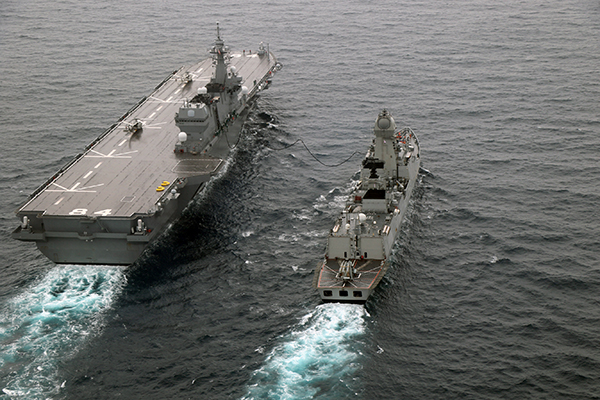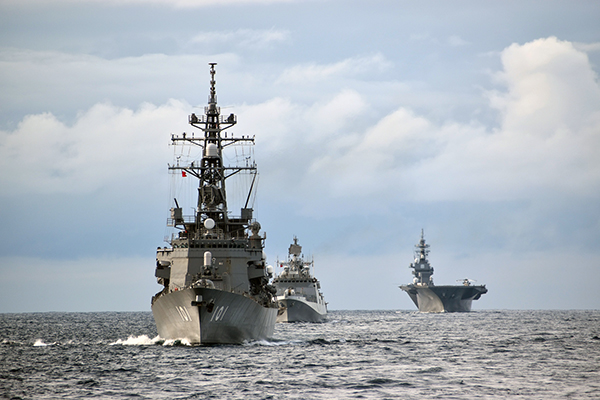The 5th edition of the bilateral maritime exercise JIMEX, between Japan and India, was conducted in the Arabian Sea on 6 – 8 October 2021. The exercise saw the ships and aircraft of Japan Maritime Self Defence Force (JMSDF) and Indian Navy (IN) engaging in a high tempo of operations focused on air, surface and sub-surface dimensions of maritime operations as well as the air domain.
The IN, under the command of Rear Adm Ajay Kochhar, Flag Officer Commanding Western Fleet, participated with indigenous guided missile destroyer, INS Kochi (with Sea King MK 42B helicopter) and the Guided Missile Frigate INS Teg (with search-and-rescue capable Chetak helicopter). The IN also fielded a P8I, a shore-based maritime reconnaissance aircraft and MiG 29K fighters. The JMSDF was led by Rear Adm IkeuchiIzuru, Commander, Escort Flotilla Three comprising of the Izumo-class helicopter carrier Kaga and the guided missile destroyer Murasame. Both ships participated with integral SH60K helicopters.
Setting the operational tempo from the start, the units exercised war-at-sea scenario with P8I (IN) providing maritime reconnaissance support to both navies. The units practised replenishment at sea approaches and undertook fuel rig connect-up between Kaga and Kochi. The exercise also involved complex over-the-horizon targeting exercises and surface gun shoots on an expendable target. An advanced coordinated anti-submarine exercise involving an underwater target deployed by JMSDF saw surface units and IN’s P8I aircraft exercising with seamless coordination. Flag officers of the two forces also met on the flight decks of Kochi and Kaga during flying operations, in keeping with the true spirit of military friendship.
The air domain operations included advanced anti-aircraft firing exercises on expendable aerial target launched from the deck of INS Kochi and ship controlled beyond-visual-range (BVR) combat drills by IN’s MiG 29K fighters. The exercise involved a high tempo of flying operations with MiG 29K fighters coming in for multiple simulated air strike on surface units, shepherded by the IN’s Maritime Patrol Aircraft, Dornier. The inclement weather did little to hold back IN and JMSDF helicopters from undertaking cross-deck landings, showcasing a high level of interoperability.
The precision, coordination and the high level of interoperability reflected the high standards of professionalism and preparedness the two navies maintain to counter threats at sea, and also high level of trust and understanding that they have built over the years. The complex maritime exercises undertaken will enable the two navies to further strengthen their already wide-ranging strategic partnership and, when required, to jointly safeguard their maritime interests and ensure peace, security and stability in the region.


Meanwhile, both the Indian and Japanese naval forces had been active outside of JIMEX as well. The Indian Navy conducted the fourth edition of AUSINDEX, between the Indian Navy and the Royal Australian Navy. During the exercises from September 6-10, the Indian contingent included INS Shivalik and Kadmatt, the most recent indigenously designed and developed guided missile stealth frigate and anti-submarine corvette respectively, part of the Indian Navy’s Eastern Fleet based in Visakhapatnam in southern India. The Australian side was represented by the Anzac-class frigate HMAS Warramunga, which also took part in the Malabar exercises. According to an Indian press release, the 2021 edition of AUSINDEX included complex surface, sub-surface, and air operations between ships, submarines, helicopters, and long-range maritime patrol aircraft of the participating navies, with the goal of strengthening interoperability and developing a shared understanding of processes and procedures for maritime security operations.
The JMSDF, too, had a busy schedule. There was a major naval exercise in the waters off the southeast of Okinawa involving six participating navies – the U.S. Navy, the U.K. Royal Navy, the JMSDF, the Royal Netherlands Navy, the Royal Canadian Navy and the Royal New Zealand Navy – with a total of 17 surface ships, including four aircraft carriers. According to a press release issued by the JMSDF, the exercise was meant to bolster the Japanese forces’ “tactical skills and interoperability with the participating navies.” The exercise involved anti-submarine warfare, air defense warfare, tactical movement, and communications training.













